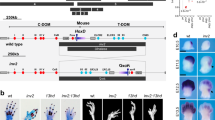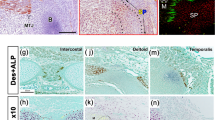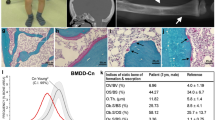Abstract
Mutations in the human SRY–related gene, SOX9, located on chromosome 17, have recently been associated with the sex reversal and skeletal dysmorphology syndrome, campomelic dysplasia. In order to clarify the role of this gene in skeletal development, we have studied the expression of mouse Sox9 during embryogenesis. Sox9 is expressed predominantly in mesenchymal condensations throughout the embryo before and during the deposition of cartilage, consistent with a primary role in skeletal formation. Interspecific backcross mapping has localized mouse Sox9 to distal chromosome 11. The expression pattern and chromosomal location of Sox9 suggest that it may be the gene defective in the mouse skeletal mutant Tail–short, a potential animal model for campomelic dysplasia.
This is a preview of subscription content, access via your institution
Access options
Subscribe to this journal
Receive 12 print issues and online access
$209.00 per year
only $17.42 per issue
Buy this article
- Purchase on Springer Link
- Instant access to full article PDF
Prices may be subject to local taxes which are calculated during checkout
Similar content being viewed by others
References
Davis, R.L., Weintraub, H. & Lassar, A.B. Expression of a single transfected cDNA converts fibroblasts into myoblasts. Cell 51, 987–1000 (1987).
Koopman, P., Gubbay, J., Vivian, N., Goodfellow, P. & Lovell–Badge, R. Male development of chromosomalty female mice transgenic for Sry. Nature 351, 117–121 (1991).
Jantzen, H.-M., Admon, A., Bell, S.P. & Tjian, R. Nucleolar transcription factor hUBF contains a DNA-binding motif with homology to HMG proteins. Nature 344, 830–836 (1990).
Giese, K., Cox, J. & Grosschedl, R. The HMG domain of lymphoid enhancer factor 1 bends DNA and facilitates assembly of functional nucleoprotein structures. Cell 69, 185–195 (1992).
Harley, V.R., Lovell-Badge, R. & Goodfellow, P.N. Definition of a consensus DNA binding site for SRY. Nucl. Acids Res. 22, 1500–1501 (1994).
van de Wetering, M., OostefWegel, M., Dooijes, D. & Clevers, H. Identification and cloning of TCF-1, a T lymphocyte-specific transcription factor containing a sequence-specific HMG box. EMBO J. 10, 123–132 (1991).
Van de Wetering, M., Oosterwegel, M., van Norren, K. & Clevers, H. Sox-4, an Sry-like HMG box protein, is a transcriptional activator in lymphocytes. EMBO J. 12, 3847–3854 (1993).
Denny, P., Swift, S., Connor, F. & Ashworth, A. An SRY-related gene expressed during spermatogenesis in the mouse encodes a sequence-specific DNA-binding protein. EMBO J. 11, 3705–3712 (1992).
Foster, J.W. et al. Campomelic dysplasia and autosomal sex reversal caused by mutations In an SRY-related gene. Nature 372, 525–530 (1994).
Wagner, T. et al. Autosomal sex reversal and campomelic dysplasia are caused by mutations in and around the SRY-related gene SOX9. Cell 79, 1111–1120 (1994).
OMIM™ online database. Johns Hopkins University; Baltimore, MD. MIM Number 211970: Camptomelic dwarflsm. Date last edited: October 10, 1993.
Lee, F.A., Issacs, H. & Strauss, J. The ‘camptomelic’ syndrome. Short life-span dwarflsm with respiratory distress, hypotonla, peculiar fades, and multiple skeletal and cartilaginous deformities. Am. J. Dis. Child. 124, 485–496 (1972).
Houston, C.S. et al. The campomelic syndrome: review, report of 17 cases, and follow-up on the currently 17–year–old boy first reported by Maroteaux et al. in 1971. Am. J. med. Genet. 15, 3–28 (1983).
Wright, E.M., Snopek, B. & Koopman, P. Seven new members of the Sox gene family expressed during mouse development. Nucl. Acids Res. 21, 744 (1993).
Kozak, M. The scanning model for translatlon: an update. J. Cell Biol. 108, 229 (1989).
Mermod, N., O'Neill, E.A., Kelly, T.J. & Tjian, R. The proline-rich transcriptional activator of CTF/NF-1 is distinct from the replication and DNA binding domain. Cell 58, 741–753 (1989).
Courey, A.J. & Tjian, R. Analysis of SP-1 in vivo reveals multiple transcriptional domains, including a novel glutamine-rich activation motif. Cell 55, 887–898 (1988).
Clerc, R.G., Corcoran, L.M., LeBowitz, J.H., Baltimore, D. & Sharp, P.A., The B-cell-specific Oct-2 protein contains POU box-and homeobox-type domains. Genes Dev. 2, 1570–1581 (1988).
Scheidereit, C. et al. A lymphoid-specific transcription factor that activates immunoglobulin genes is a homeobox protein. Nature 336, 551–557 (1988).
Muller, M.M., Ruppert, S., Schaffner, W. & Matthias, P. A cloned octamer transcription factor stimulates transcription from lymphoid-specific promoters in non-B cells. Nature 336, 544–551 (1988).
Norman, C., Runswick, M., Pollock, R. & Treisman, R. Isolation and properties of cDNA clones encoding SRF, a transcription factor that binds to the c-fos serum response element. Cell 55, 989–1003 (1988).
Lillie, J.W. & Green, M.R. Transcriptional activation by the adenovirus E1a protein. Nature 338, 39–44 (1989).
Buchberg, A.M. & Camper, S.A. Mouse chromosome 11. Mamm. Genome 4, S164–S175 (1993).
Morgan, W.C., A new Tall-short mutation in the mouse. J. Hered. 41, 208–215 (1950).
Deol, M.S. Genetical studies on the skeleton of the mouse XXVIII. Tail-short. Proc. roy. Soc. Lond. B. 155, 78–95 (1961).
Rodriguez, J.I. Vascular anomalies in campomelic syndrome. Am. J. med. Genet 46, 185–192 (1993).
Koopman, P., Münsterberg, A., Capel, B., Vivian, N. & Lovell–Badge, R. Expression of a candidate sex-determining gene during mouse testis differentiation. Nature 348, 450–452 (1990).
Kingsley, D.M. What do BMPs do in mammals? Clues from the mouse short-ear mutation. Trends Genet. 10, 16–21 (1994).
Tommerup, N. et al. Assignment of an autosomal sex reversal locus (SRA1) and campomelic dysplasia (CMPD1) to 17q24.3–q25.1. Nature Genet. 4, 170–174 (1993).
Hovmoller, M.L. et al. Camptomelic dwarfism. A genetically determined mesenchymal disorder combined with sex reversal. Hereditas 86, 51–62 (1977).
Gubbay, J. et al. A gene mapping to the sex-determining region of the mouse Y chromosome Is a member of a novel family of embryonically expressed genes. Nature 346, 245–250 (1990).
Wilkinson, D.G. & Nieto, M.A. Detection of messenger RNA by in situ hybridisation to tissue sections and wholemounts. Methods Enzymol. 225, 361–373 (1993).
Ojeda, J.L., Barbosa, E. & Gomez Bosque, P. Selective staining in whole chicken embryos; a rapid alcian blue technique. Stain. Technol. 45, 137–138 (1970).
Sambrook, J., Fritsch, E.F. & Maniatis, T. Molecular cloning: a laboratory manual. 2nd edn (Cold Spring Harbor Press, New York, 1989).
The European Baclcross Collaborative Group. Towards high resolution maps of the mouse and human genomes—a facility for ordering markers to 0.1 cM resolution. Hum. molec. Genet. 3, 621–627 (1994).
Author information
Authors and Affiliations
Rights and permissions
About this article
Cite this article
Wright, E., Hargrave, M., Christiansen, J. et al. The Sry-related gene Sox9 is expressed during chondrogenesis in mouse embryos. Nat Genet 9, 15–20 (1995). https://doi.org/10.1038/ng0195-15
Received:
Accepted:
Issue Date:
DOI: https://doi.org/10.1038/ng0195-15
This article is cited by
-
Fructose-bisphosphatase1 (FBP1) alleviates experimental osteoarthritis by regulating Protein crumbs homolog 3 (CRB3)
Arthritis Research & Therapy (2023)
-
Reprogramming of human peripheral blood mononuclear cells into induced mesenchymal stromal cells using non-integrating vectors
Communications Biology (2023)
-
A Maverick Review of Common Stem/Progenitor Markers in Lung Development
Stem Cell Reviews and Reports (2022)
-
Methylsulfonylmethane enhances MSC chondrogenic commitment and promotes pre-osteoblasts formation
Stem Cell Research & Therapy (2021)
-
Both microRNA-455-5p and -3p repress hypoxia-inducible factor-2α expression and coordinately regulate cartilage homeostasis
Nature Communications (2021)



